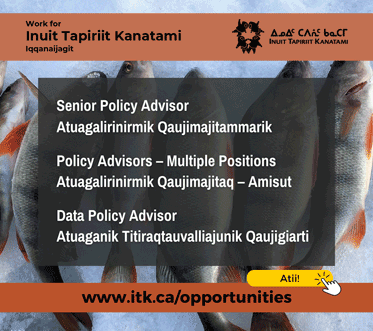Ottawa unveils repackaged northern blueprint
“This is not an exercise in promise-making”
It’s an announcement that amounts to new packaging for an old theme.
A trio of federal cabinet ministers unveiled Canada’s Northern Strategy in Gatineau, Que. this past Sunday, with a website and 48-page document that largely outlines what the Conservative government has already done on the Arctic sovereignty front.
Chuck Strahl, minister of Indian and Northern Affairs, told a news conference the strategy rests on four pillars:
- exercising Canada’s sovereignty over the Arctic;
- promoting social and economic development;
- protecting the North’s environment, and;
- improving and devolving northern governance.
“We have a clear vision for Canada’s North and are working to ensure it achieves its true promise as a healthy, prosperous region within a strong and sovereign nation,” Strahl said, according to speaking notes provided by his office. “This is not an exercise in promise–making.”
The Conservatives have committed to pouring billions into the North in the form of housing, research funding, military hardware and infrastructure: everything from $720 million for a new polar icebreaker to $50 million to start up a new northern economic development agency that’s rumoured to be headquartered in Iqaluit.
But the North in general, and Nunavut in particular, still faces a massive infrastructure gap and lower health and educational outcomes than southern Canadians.
There’s no indication in the Northern Strategy of what might come next on longstanding wish-list projects such as small craft harbours, Iqaluit’s port and other big-ticket infrastructure needs.
But Leona Aglukkaq, Nunavut’s MP and the federal health minister, defended the document in an interview Tuesday, saying this is the first time Canada has had a strategy for the North laid out on paper.
“I think it’s important to consolidate all the initiatives we’re doing for Canadians to see…what we’re doing within our government for the North,” Aglukkaq said.
And she said ongoing elements of the plan, like devolution negotiations with the Government of Nunavut and Nunavut Tunngavik Inc., and infrastructure funding from gas tax and Building Canada infrastructure funds, will reap economic benefits over the long term.
But Rhoda Innuksuk, president of Pauktuutit, Inuit Women of Canada, who attended the news conference Sunday, said she’s concerned about whether enough of Ottawa’s largesse will reach Inuit.
The federal government should consult with Inuit and other northern aboriginal groups to find out what communities need, she said.
“I wouldn’t want to see Inuit just getting the crumbs of that money,” she said.
Ottawa must listen to Inuit to ensure culture and the environment are protected, Innuksuk said.
That includes using Inuit Qaujimajatuqangit to guide decisions on where to locate a new Arctic research station and how to ensure increased icebreaker traffic doesn’t harm whale populations.
“Money should not be the only voice up North,” she said.
Aglukkaq said the government consults regularly with Inuit, citing discussions with the hamlet of Pangnirtung on the construction of a small craft harbour and work with Inuit organizations on economic development funding.
The Northern Strategy document also seeks to cool boiling rhetoric that depicts the Arctic as a region where the five coastal states — Canada, Denmark-Greenland, Russia, the United States and Norway —are destined to do battle over the region’s vast potential deposits of natural resources.
So while the strategy boasts that Canada is “putting more boots on the Arctic tundra, more ships in the icy water and a better eye in the sky [a reference to the Polar Epsilon II satellite surveillance project]” it also stresses cooperation with Canada’s polar neighbours.
Canada is beefing up marine regulations in the North and is dispatching diplomats and scientists to manage territorial disputes with Denmark and the United States, the strategy states.
It’s also mapping the Arctic seafloor to build its claim for territory under the United Nations Convention on the Law of the Sea, which is due in 2013.
“This process, while lengthy, is not adversarial and is not a race,” the document reads. “Rather, it is a collaborative process based on a shared commitment to international law.”
Still, in a recent paper, University of Calgary political scientist Rob Huebert writes that Canada must boost its surveillance and enforcement capability in the Arctic. He also suggests a cabinet committee, chaired by the Prime Minister, focused solely on Arctic issues.
“Only by ensuring that the Prime Minister is continuously engaged in Arctic issues will attention to the region be maintained,” Huebert wrote.





(0) Comments